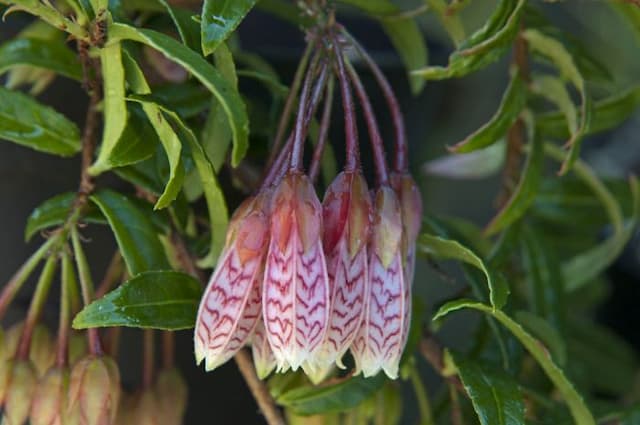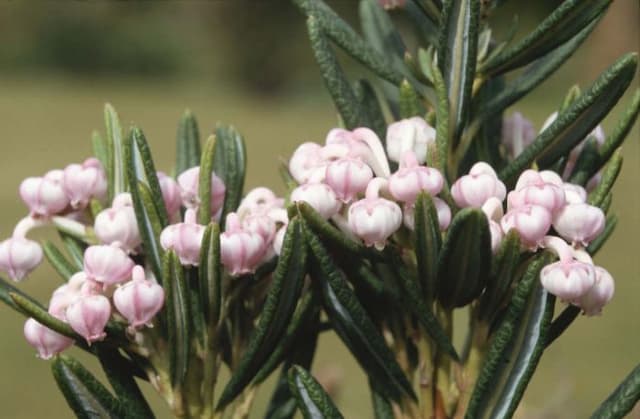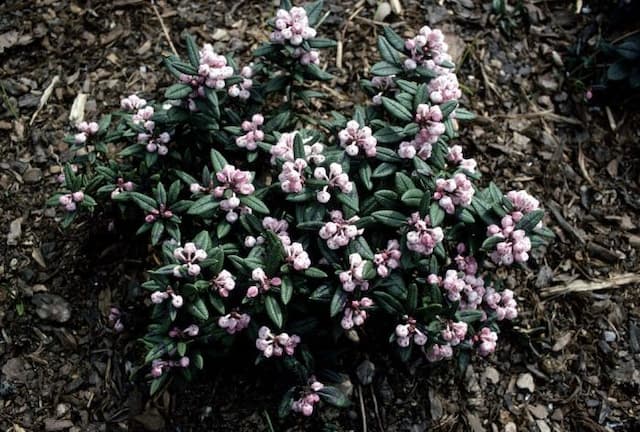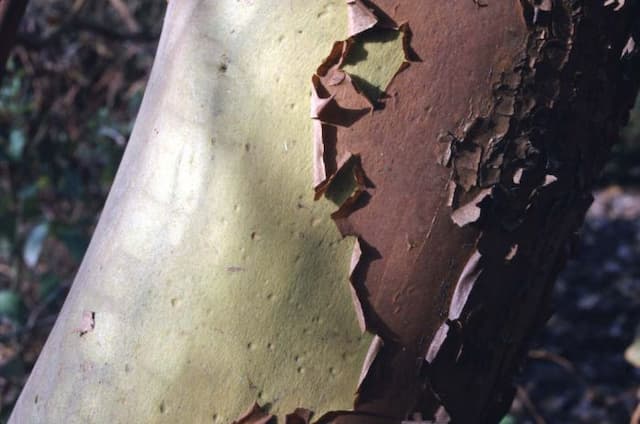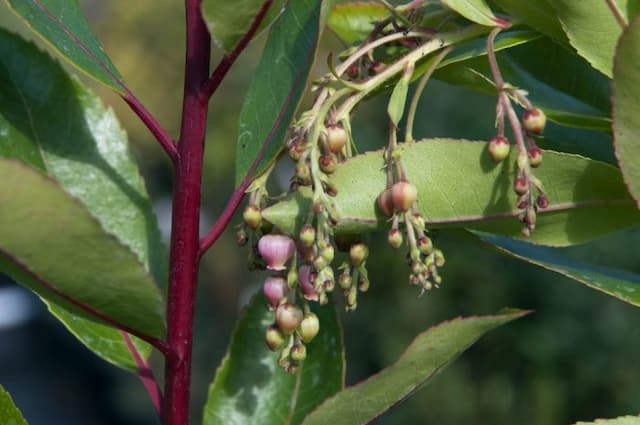Calluna vulgaris 'Anette' (PBR) (Garden Girls Series)

ABOUT
The Calluna vulgaris 'Anette' (Garden Girls Series), commonly known as heather, boasts a distinctive appearance characterized by its dense foliage and vibrant floral display. The foliage consists of small, needle-like leaves that densely cover the plant, providing a lush texture. The leaves are typically a deep green color, which forms a rich backdrop for the flowers. The blooms of this particular variety are notable for their color and form. They appear in profuse clusters, creating a striking visual impact. The flowers are often a radiant shade, with some showcasing a gradient or variations in hue, adding depth and interest to the display. These blooms are a favorite among gardeners looking to inject color into their landscape during the flowering season. Additionally, the compact and bushy nature of this heather lends itself to shaping and is often used as ground cover or as part of decorative borders in gardens. The plant's overall form is well-balanced and neat, making it an attractive addition to both formal and informal garden settings. It's important to note that when referencing the Calluna vulgaris 'Anette' (Garden Girls Series), the focus is usually on its ornamental qualities, such as the texture, color, and arrangement of its leaves and flowers, rather than its specific size. Hence, the aesthetic appeal lies in the dense foliage and bright flowers that contribute to its popularity in garden design.
About this plant
 Names
NamesFamily
Ericaceae.
Synonyms
Heather, Ling, Scotch Heather.
Common names
Calluna vulgaris 'Anette' (PBR) (Garden Girls Series).
 Toxicity
ToxicityTo humans
Heather is generally not considered toxic to humans. However, it is always recommended to refrain from ingesting plants that are not explicitly intended for consumption, as individual allergies or sensitivities could occur.
To pets
Heather is not known to be toxic to pets. It's typically safe for cats, dogs, and other domestic animals. Nevertheless, ingestion of plant material can sometimes cause mild stomach upset in some animals due to individual sensitivities.
 Characteristics
CharacteristicsLife cycle
Perennials
Foliage type
Evergreen
Color of leaves
Green
Flower color
Pink
Height
1-2 feet (30-60 cm)
Spread
1-2 feet (30-60 cm)
Plant type
Shrub
Hardiness zones
5
Native area
Europe
Benefits
 General Benefits
General Benefits- Low Maintenance: Calluna vulgaris 'Anette' is known for being easy to care for, requiring minimal upkeep throughout the year.
- Drought Tolerance: Once established, this plant has good resistance to drought, reducing the need for frequent watering.
- Year-Round Interest: With evergreen foliage and long-lasting blooms, 'Anette' provides garden interest across all seasons.
- Attracts Pollinators: Its flowers attract bees and butterflies, promoting biodiversity in the garden.
- Winter Hardiness: This plant can tolerate cold temperatures, making it suitable for a variety of climates.
- Soil Adaptability: It can thrive in a range of soil types, provided they are well-draining.
- Compact Growth: The 'Anette' cultivar has a compact and neat growth habit, ideal for small gardens and containers.
- Color Variety: The flowers and foliage offer a range of colors, adding visual appeal to garden landscapes.
- Erosion Control: The plant's dense growth can help stabilize soil and prevent erosion on slopes.
- Versatile Landscaping: Suitable for rock gardens, borders, ground cover, and as an ornamental feature.
 Medical Properties
Medical PropertiesThis plant is not used for medical purposes.
 Air-purifying Qualities
Air-purifying QualitiesThis plant is not specifically known for air purifying qualities.
 Other Uses
Other Uses- Heather 'Anette' can be used in the craft of making miniature realistic landscapes for model trains or fantasy dioramas due to its small scale and dense foliage.
- It can be planted over graves as a natural grave marker that blends with the surrounding landscape and offers year-round greenery.
- Heather's branches can be woven into decorative wreaths and garlands for festive occasions, adding a touch of natural beauty to decorations.
- Dried Heather can serve as an aromatic filler in sachets and potpourris, providing a subtle, earthy fragrance to wardrobes or rooms.
- It can be used in natural dye making, where the flowers give a range of colors from green to yellow, depending on the mordant used.
- Pressed Heather flowers can be incorporated into homemade paper for a textured and ornamental appearance.
- Heather can be used as an eco-friendly garden mulch to suppress weeds and add organic matter to the soil as it decomposes.
- Live Heather plants can be given as eco-friendly gifts or favors for events like weddings or parties, symbolizing good luck and protection.
- Heather 'Anette' can be utilized in sensory gardens, providing not just visual interest but also a unique tactile experience due to its fine foliage.
- It can be planted to help stabilize soil on slopes or banks, providing erosion control in garden landscapes or restoration projects.
Interesting Facts
 Feng Shui
Feng ShuiHeather is thought to influence physical and energetic aspects of life in Feng Shui. To use Heather in Feng Shui, it should be placed in the bagua areas associated with family (east), wealth (southeast), or fame (south), as it brings an energy of fortune and can be used to create a shield of protection or to purify the air.
 Zodiac Sign Compitability
Zodiac Sign CompitabilityHeather is not used in astrology practice.
 Plant Symbolism
Plant Symbolism- Protection: Calluna vulgaris, commonly known as heather, is often associated with protection due to its hardy nature and historical use in thatching roofs to safeguard homes from adverse weather.
- Good fortune: Heather is considered a lucky symbol, especially in Scottish tradition, where carrying a sprig is believed to bring good luck.
- Admiration: The plant’s ability to thrive on barren landscapes symbolizes admiration for resilience and overcoming obstacles.
- Solitude: Heather’s preference for growing in quiet, undisturbed places has made it a symbol of solitude and contemplation.
- Beauty: With its delicate flowers, the heather plant is often associated with beauty and has been celebrated in poetry and art for its aesthetic appeal.
 Water
WaterHeather requires regular watering to keep the soil consistently moist but not waterlogged. During the growing season, water approximately once or twice a week, depending on weather conditions—you want to aim for about 1 to 1.5 gallons per week for an established plant. In hotter, dryer periods, water may be needed more frequently to maintain moisture levels. It's important to reduce watering in the winter when the plant is dormant; water less frequently, making sure the soil doesn't completely dry out. Always check the top inch of the soil for dryness and water accordingly. Avoid overhead watering to reduce the risk of fungal diseases.
 Light
LightHeather thrives in full sun to partial shade. It does best when it receives at least 4-6 hours of sunlight per day. The best spot for heather is a location where it can enjoy morning sunlight and some afternoon shade, especially in hotter climates, to prevent scorching. Avoid deep shade as it can lead to poor flowering and leggy growth.
 Temperature
TemperatureHeather is a hardy plant that can withstand cold temperatures, often down to around 14°F. The ideal temperature range for heather is between 60°F and 70°F. It can survive in temperatures up to about 75°F but may struggle in prolonged heat, especially if not adequately watered. As a rule of thumb, heather should be protected from extreme temperatures both hot and cold.
 Pruning
PruningPruning heather is done to maintain its shape and to encourage vigorous growth. Prune the plant immediately after flowering finishes in late spring to prevent cutting off next year's buds. Trimming back the faded flower spikes and lightly shaping the plant will keep it looking full and bushy. Pruning should be done annually to prevent the heather from becoming woody and sparse.
 Cleaning
CleaningAs needed
 Soil
SoilHeather, or Calluna vulgaris 'Anette', thrives best in well-draining, acidic soil with a pH between 4.5 and 5.5. A mix of peat moss, sand, and loamy soil in equal parts generally works well. Ensuring good drainage and avoiding overly fertile soils will promote the health of the plant.
 Repotting
RepottingHeathers, such as Calluna vulgaris 'Anette', typically require repotting every 3 to 5 years. It's best to repot in the spring before new growth starts, using a suitable acidic soil mix as mentioned above.
 Humidity & Misting
Humidity & MistingHeathers, particularly Calluna vulgaris 'Anette', prefer moderate humidity levels. While they can tolerate some dryness, they don't thrive in highly arid or extremely moist environments. Aim for a balance that mimics their natural moorland habitat.
 Suitable locations
Suitable locationsIndoor
Place in bright, indirect light with acidic soil.
Outdoor
Plant in well-draining, acidic soil; full sun to part shade.
Hardiness zone
4-7 USDA
 Life cycle
Life cycleHeather 'Anette' (Calluna vulgaris 'Anette' PBR, Garden Girls Series) begins its life cycle as a seed, germinating in a well-draining, acidic soil with plenty of sunlight. The seedling emerges and develops into a young plant with characteristic needle-like leaves and woody stems, entering a vegetative growth phase that can last several years. During this time, the heather plant establishes a strong root system and foliage, preparing for the flowering stage. The mature plant blooms in late summer to autumn, producing spikes of beautiful small, mauve to purple flowers that attract pollinators like bees and butterflies. Post-flowering, seeds are produced and dispersed, but this cultivar, being a patented vegetatively reproduced variety, is primarily propagated through cuttings to retain its unique characteristics. As winter approaches, heather becomes dormant, with evergreen foliage providing year-round interest, before resuming growth in the spring, completing the annual cycle.
 Propogation
PropogationPropogation time
Late summer
Propogation: The most popular method of propagating the Calluna vulgaris 'Anette', commonly known as Heather, is by semi-ripe cuttings. This is typically done in late summer. To propagate using this method, a gardener would select a healthy, non-flowering shoot and cut a length of about 2 to 4 inches (5 to 10 centimeters), ensuring the cutting includes a heel (a small piece of the older wood at the base of the cutting). The lower leaves are stripped off, and the cut end is dipped into rooting hormone powder to encourage root growth. The cutting is then inserted into a pot filled with a mixture of peat and coarse sand or a peat-free alternative, which provides the necessary drainage and aeration required for root formation. The cutting is watered gently and placed in a cold frame or a similarly sheltered spot until roots have developed, after which it can be potted on or planted out.
